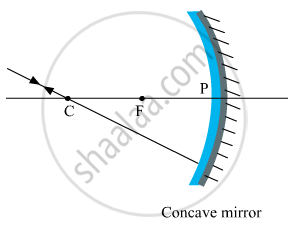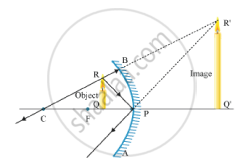Advertisements
Advertisements
प्रश्न
To construct a ray diagram we use two rays which are so chosen that it is easy to know their directions after reflection from the mirror. List two such rays and state the path of these rays after reflection in case of concave mirrors. Use these two rays and draw ray diagram to locate the image of an object placed between pole and focus of a concave mirror.
उत्तर
Two light rays whose path of refection are priorly know are:
(i) The incident ray passes through the centre of curvature: In this case, light after reflecting from the concave mirror moves back in the same path. This happens because light is incident perpendicularly on the mirror surface.

(ii) The ray incident obliquely to the principal axis: In this case, the incident ray will be reflected back by the reflecting surface of the concave mirror obliquely and making equal angles with the principal axis.

Let an object "a candle" is placed between the focus and pole of the concave mirror. Then using above two rays, image of the candle can be located as shown below:

In this case, the image is formed behind the mirror. This image is virtual, erect and magnified.
APPEARS IN
संबंधित प्रश्न
Draw the following diagram in which a ray of light is incident on a concave/convex mirror on your answer sheet. Show the path of this ray, after reflection, in each case.

Fill in the following blank with suitable word:
Parallel rays of light are reflected by a concave mirror to a point called the ..........
Draw the following diagram in your answer book and show the formation of image with the help of suitable rays:
Make labelled ray diagrams to illustrate the formation of:
a virtual image by a converging mirror.
Mark clearly the pole, focus, centre of curvature and position of object in each case.
One of the following does not apply to a concave mirror this is:
(a) focal length is negative
(b) image distance can be positive or negative
(c) image distance is always positive
(d) height of image can be positive or negative
Name the lens which can concentrate sun's rays to a point and burn a hole in a piece of paper.
With the help of a labelled diagram, explain how a concave lens diverges a beam of parallel light rays. Mark the principal axis, optical centre, principal focus and focal length of the concave lens on the diagram.
A student determines the focal length of a device 'X' by focusing the image of a distant object on a screen placed 20 cm from the device on the same side as the object. The device 'X' is
(a) Concave lens of focal length 10 cm
(b) Convex lens of focal length 20 cm
(c) Concave mirror of focal length 10 cm
(d) Concave mirror of focal length 20 cm
A concave mirror produces a magnification of +4. The object is placed ______.
To obtain an image twice the size of the object, between which two points related to a concave mirror should an object be placed?
